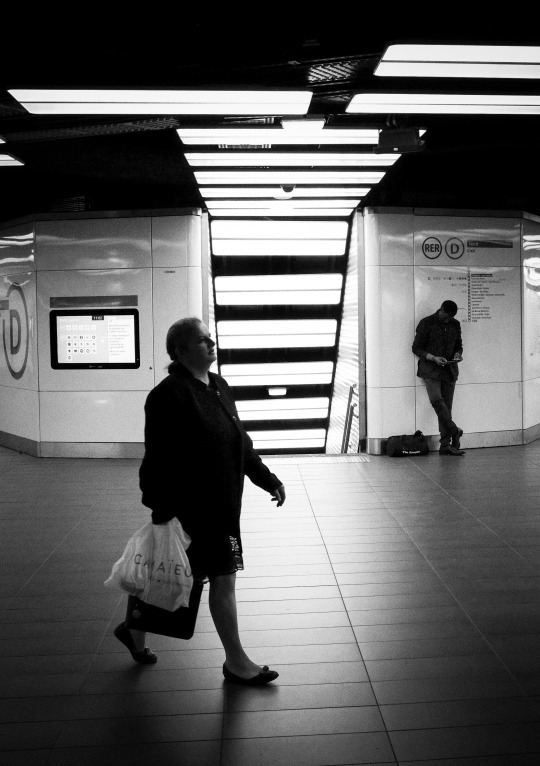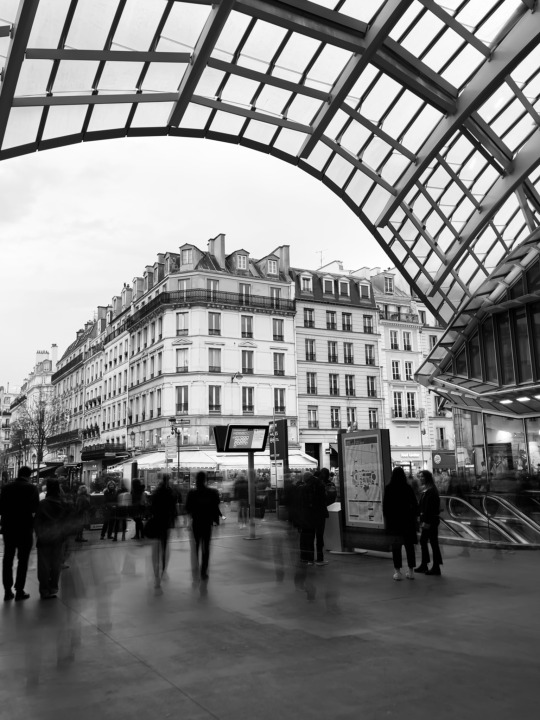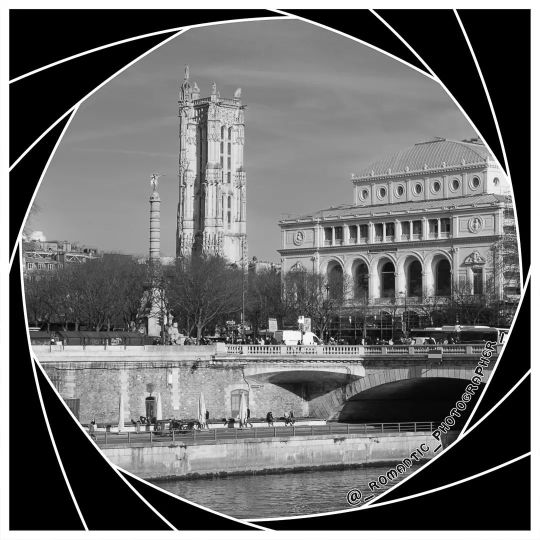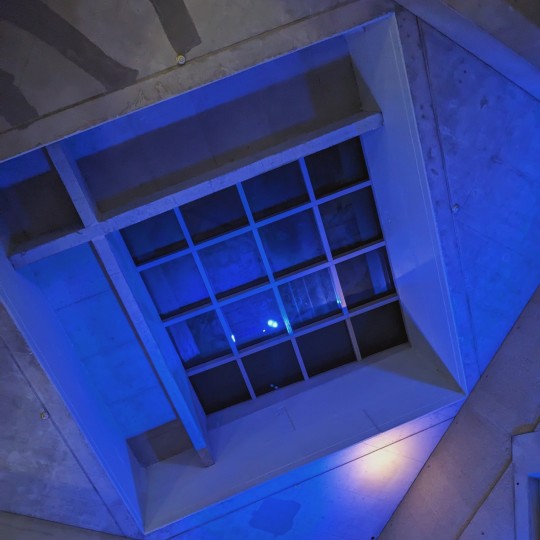#Chatelet les halles
Text
youtube
Bon Matin 💙🗼💙
Florent Pagny 🎶 Chatelet Les Halles
#clip video#florent pagny#music video#chatelet les halles#chanson paris#clip music video#les halles#youtube#bon matin#fidjie fidjie
20 notes
·
View notes
Text

Châtelet-les Halles Paris
Photo: Dieter Krehbiel
#source:forthepleasureofmylife#chatelet les halles#metro#metro station#paris#france#green eyes 55#dieter krehbiel#photography#black and white#urban#street photography#photographers on tumblr#black and white photography#urban life#urban photography#source: forthepleasureofmylife#neon lights#neon aesthetic#waiting
19 notes
·
View notes
Text
i speak up on steve harrington once & then my new summer haircut attracts all variety of sexually confused strangers. feels correct
#qui parle#the people on the rer a direction chatelet les halles trying to figure out if im a tomboy or a pretty boy. lol#my hair grows so fast that i get to play w it a lot whenever it occurs to me that i possess a physical body
4 notes
·
View notes
Text

Chatelet les Halles RER stop in the early 00s. Shot with a Fujifilm digicam
3 notes
·
View notes
Photo


Source: L'Afrique du Nord illustrée, 15 July 1933
Image Source
We know with what cruelty the Thénardier woman martyrizes Cosette, the little girl abandoned by Fantine. Greed and jealousy animates this detestable shrew; The only sentiment she has to redeem her from infamy is the height of her maternal feelings. She loves her two girls, Eponine and Azelma to the point of madness; she supports their whims, she excuses the way the one bullies Cosette and excuses the cowardice of the other.
The roles of child Eponine and child Azelma in the new version of Les Misérables by Raymond Bernard were played by mademoiselles Gilberte Samary and Jacqueline Fernez.
Gilberte Samary debuted in the cinema at the age of 5 in “La Faute de Monique.” She also appeared in “Le Collier de la Reine,” “La Ronde des Heures,” “Le Vieux Garçon,” and “Le Reve.” She was also applauded in la Boite a Joujoux and the music halls of the countryside. Tall, blonde, with an expressive face and a penetrating gaze, Gilberte doesn’t give off the impression of a nervous and shy little debutante. She maneuvers very freely through the studio and is amused by a phrase or attitude. She often has funny, ironic, or picturesque quips. While Mademoiselle Marguerite Moreno [Mme. Thénardier] has only just arrived on Raymond Bernard’s plate, Gilberte is becoming a great actress and she asks:
“To get here at 9 o’clock, what time do you have to wake up, Madame?”
“At seven o’clock, my dear.”
“Even so,” continues Gilberte with a funny head movement, “the things one has to do these days to get a scrap!”
I'll add that Mademoiselle Samary played the role of Eponine, the eldest Thénardier daughter, with much accuracy.
The role of Azelma was played by Mademoiselle Jacqueline Fernez. As a dancer, the little Fernez debuted at the Chatelet. Then she appeared in the Petit Monde theater and the Boite a Joujoux. At nine years old, she had not yet appeared in the cinema.
She acted with an evident good drive under the amused gaze of Gaby Triquet who, younger than her by two and a half years, was witnessing the flutters of…a little debutant.
10 notes
·
View notes
Text





.
Wednesday Wanderings and Wonderings - Walking Distance from our Domicile.
Les Halles - From the "Belly of Paris" to the "Heart of Paris"
It's hard to imagine that when, in 1110, Louis VI decided to transfert the halls from where is now place de l'Hotel de Ville (before that it was on Ile de la Cite) to this spot, the site was in the open countryside of Paris and the site of former marshes that would needed to be drained and transformed into fields.
For more than eight centuries, Les Halles remain in this location, undergoing continual transformations, to try to adapt to the ever-growing needs of the capital. But in March 1960, because of its very central location and difficulty to access by the wholesale it was decided to transfer the market from Les Halles to Rungis and La Villette but it took another 9 years to be done. This operation, considered at the time to be the “move of the century”, involved 20,000 people, 1,000 wholesale companies, 10,000 m3 of equipment, 5,000 tonnes of goods and 1,500 trucks.
After the move, the "hole" of the Halles remained for several years while several development projects remained unsuccessful. Finally in 1979 the “Forum des Halles” project is inaugurated. Once again in 2004 an architectural competition is launched by the town hall for a total renovation of the district and this is the new Canopy inaugurated in 2016.
A few random stats: It's the largest station in the city (Châtelet-Les Halles) with three RER lines, five metro lines, 15 bus lines and 13 Noctiliens lines where an average of 800,000 passengers pass daily. (NB Lots of people will avoid Chatelet-Les Halles at all cost!!). The Forum is the third largest shopping center in France with 34 million annual customers (second in Île-de-France after Quatre Temps at La Défense). It also have 26 cinemas, has the busiest swimming pool and three media libraries of the City of Paris.
ps: As far as "Wanderings and Wonderings" places, this is the closest to us (with Pompidou) but I have been procrastinating posting about it because it is so hard to photograph.
2 notes
·
View notes
Photo

La magnifique #facade du #théâtre de l' #hoteldevilledeparis sort de ravalement. Il est sublime. Quel harmonie avec le #chatelet et la #fontaine du palmier célébrant les grandes victoires du #premierempire ( telles que celles de Lodi, du pont d'Arcole, de Rivoli, des Pyramides, du Mont Thabor, de Marengo, d'Austerlitz, d'Ulm, de Iena, d'Eylau, de Dantzig, de Friedland). The magnificent façade of the town hall theater has just been renovated. He is sublime. What harmony with the Chatelet and the fountain of Palmier celebrating the great victories of the First Empire (such as those of Lodi, the Arcole bridge, Rivoli, the Pyramids, Mont Thabor, Marengo, Austerlitz, Ulm , Jena, Eylau, Danzig, Friedland). #paris #parismaville #architectureclassique #architectureparis #leicacamera #leica #leicacamerafrance #leicam #streetarchitecture #paris1900 #haussmannien #secondempire #bwphotography #noiretblanc #blackandwhite #blackandwhitephoto #bwarchitecture #bandwphotography #theatreparis #fontaineparis #parislove #parisjetaime❤️ #parisarchitecturelover #architecturefacade (à Place du Châtelet) https://www.instagram.com/p/Co70kunIG6M/?igshid=NGJjMDIxMWI=
#facade#théâtre#hoteldevilledeparis#chatelet#fontaine#premierempire#paris#parismaville#architectureclassique#architectureparis#leicacamera#leica#leicacamerafrance#leicam#streetarchitecture#paris1900#haussmannien#secondempire#bwphotography#noiretblanc#blackandwhite#blackandwhitephoto#bwarchitecture#bandwphotography#theatreparis#fontaineparis#parislove#parisjetaime❤️#parisarchitecturelover#architecturefacade
0 notes
Photo

Ma photo du jour le 16-12-2022 (à Chatelet les-Halles) https://www.instagram.com/p/CnwDZ4hNKAL/?igshid=NGJjMDIxMWI=
0 notes
Photo

El mejor descubriendo en Paris es @trantranzai !!! Impresionante su comida !! #comerenparis #comerenparisconniños #comerbienenparís #comernoenenparisfrance #resturantstylecooking #restaurantsparis (en Trantranzai chatelet-les halles) https://www.instagram.com/p/Clrvgy5DZH7/?igshid=NGJjMDIxMWI=
#comerenparis#comerenparisconniños#comerbienenparís#comernoenenparisfrance#resturantstylecooking#restaurantsparis
0 notes
Photo

Source: Le Charivari, 13 October 1862
Translation by: me (should I start putting this on all my translated posts?)
First Performances Abroad
The censor, as we know, has forbidden the play Les Misérables. This play cannot be put on in Paris. But Belgium, that liberal and hospitable land, has opened its doors to the exile’s play.
The first performance of Les Misérables will take place shorty in Brussels and all the Parisian press will convene there. Don’t believe that only the critics will go see this play, which cannot fail to obtain the greatest success. A considerable number of people will leave each day for Belgium in order to watch this play.
The 30,000 copies of the book were printed; the play will be performed 200 times.
Why not go to Bruxelles when the train trip is so prompt; one leaves in the morning after breakfast and one arrives in the evening for dinner.
But, some will object, the trip is expensive.
The northern railroad is hastening to organize pleasure trains for spectators. A moderately small sum will see messieurs Paul Meurice and Charles Hugo’s play and will be able to visit Belgium. Isn’t that charming?
As the censor is becoming more and more rigid, shortly all authors will have their work put on in Belgium, – those who are banned, that is. In this way, the best works will be put on in Brussels. Poor Paris, what will be left there! Henceforth, when a play is refused by the censor, the author will no longer rip out his hair.
“My comedy has just been banned,” he will hasten to tell everyone.
“Is that what is making you so joyous?”
“Certainly, the committee trembled while reading my play.”
“So there are some truly strong things in it?”
“The censor trembles over so little! But I hope that my comedy will produce a very strong effect the day of its first performance.”
“But it has been banned!”
“That’s true; but I am taking it tonight to Belgium…I am offering you a ticket for the first show.”
All authors who have been victims of the severity of the censor are in the greatest joy. Yesterday night I encountered 18 who were turning up with their literary baggage at the Gard du Nord. They were leaving to have their banned plays put on.
One must hope that authors will be permitted to glue on the walls of Paris posters advertising shows in the theaters of Brussels, so that the public can know what is being played in this or that theater, as well as the hour at which the show will begin. The posters will be designed like this:
THEATRE DE LA MONNAIE
First performance of The Guilty Girl, a comedy in five acts.
Nota bene. – The Parisian censors cut this play from the first act to the last. They did not permit anything but the title. We are therefore counting on a great success.
And also:
THEATRE DES GALERIES SAINT-HUBERT
103rd performance of The French Revolution, a drama in 5 acts and 12 tableaus.
Nota bene (always) – This play would have been put on in the Theatre Imperial du Chatelet, but when the censors became aware, 3 out of 6 had an apoplectic attack. This play is on it’s 103rd performance and the hall is always full.
These signs posted in Paris will be very useful. But that will not be enough, it will also be necessary that there be an office located at the landing of the northern railroad, because it would be disagreeable to go to a play in Belgium, only to arrive and be told that there are no more places. But a bureau established in Paris and the electric telegraph will be there to avoid that inconvenience.
These performances abroad deserve our endorsement, but there is one thing to fear: that Parisian husbands will take advantage of it.
When he wants to amuse himself, he will tell his wife that he intends to go to the Theatre de la Monnaie with his friends. And this joker could very well not return home for three days, all while never leaving Paris. One must be suspicious of husbands, to them all pretexts are fair.
Also, Madame, if monsieur your husband tells you that he intends to go see a performance of Les Misérables, ask that he reserve two seats, one for him and one for you.
A. Bremond.
6 notes
·
View notes
Text
18 August 1997 - last full day, spending in Paris, returning in late May 1998
Monday 18 August 1997
Bonjour mesdames et messieurs!
Today the 18th August 1997 is the last full day of my time in Europe for 1997. Because yesterday was a Sunday, I was unable to shop in any grocery store, record store or anything similar that was not along the Champs des Elysées. One question - this year will I see the Stravinsky Fountains, or will I have to wait until May 1998?
One thing I forgot to mention, one of my adventures on 17th August, was going to Porte des Lilas on line 11. I think Serge Gainsbourg made a song about Lilas, working as a poinconneur - here is a link to that song https://www.youtube.com/watch?v=7CHHsd46rcc. I ended up crossing the Peripherique and I saw a kosher store, that was closed on Saturday but open Sunday. I could not enter the store as it had closed for the day. I think it was about 8:30 or 8:45 PM as the sun was getting close to setting.
About 7 AM I woke up, took a shower and went down to breakfast. Breakfast was just breadrolls, butter and the seasonal jam, thinking it might be strawberry - they used apricot on other occasions that I stayed there. And of course coffee or cocoa. After breakfast I walked to the local Monoprix. I bought some goat cheese, lunchmeat and sweet bread. Then I was ready to go on my adventure in the west part of the city.
At Ledru Rollin, I bought a two zone Mobilis carte orange. I would not be able to use it for La Défense by RER but I could still take Metro line 1, and any other mode of transportation within the RATP zones 1 and 2. I took the line 8 to Auber, changed to a line 3 to Gare St. Lazare, and boarded a Banlieu train, which in 2022 would be the equivalent of RER J or L. It was supposed to go to Pereire Levallois, but I could only go as far as Pont Cardinet and take a shuttle bus to Pereire Levallois. About ten minutes later I boarded the RER C to Champ de Mars for the Eiffel Tower. I walked a bit towards the Champ de Mars and then across the Seine to Passy to see how many days until the year 2000 were left. I would do something similar on Wednesday 26th May 1998 when I returned, so I could see how many days had passed. It was a really hot day, and there were some young people, maybe 12 to 15 years old, selling water and soda, for 5 FF upwards. At the time, the US Dollar was worth a little more than 5 FF. I had my own water with me.
I wanted to go to the Centre Georges Pompidou to see the Stravinsky fountains, so I took the M6 from Passy to CdG Étoile and changed to the M1, and then at Chatelet I exited to the shopping mall above the Les Halles station. I was able to find the Centre Georges Pompidou, but at the time I did not know that the Stravinsky fountains were, if you were to walk towards Rambuteau station and the Marais, on the right side. Just simply going to Centre Georges Pompidou, will not lead a person to the fountains, because it requires knowing that one must walk a bit farther east and then look right. Well, I did not know about that in August 1997, but it was something that was corrected for my next visit in May 1998. And all was good in a matter of a few months thereafter.
After my mishap at Centre Georges Pompidou, I decided to carry on to Chateau Vincennes. I could take the RER A to Nation and change to the M1 for the remainder of the journey. I did see the castle at Vincennes. It has a building at the southern end, walls between the two buildings on the west and east side, and a chapel towards the north. It is a nice castle. To the east of the castle is where the 24th Regiment of the infantry is located. It is similar to the Fort de Bicêtre that I had seen the front gate of, in March 2000.
I left the Chateau Vincennes by M1 for Nation and transferred to a RER A for CdG Étoile. Along the way, I happened to run into one of my former roommates who actually was a French national. It was quite a chance meeting, seeing him on an RER train. I told him about working the last few months in Munich. We left at CdG Étoile. I transferred to the M1 for Esplanade de La Défense. I wanted to see the Bassin Takis and see if the lights were glowing, once again. I also walked to the other side of the complex, to see La Jetée. There, there were some similar light poles that had the same function as those at Bassin Takis.
I took the M1 from La Défense to CdG Étoile and had one last walk down Champs des Elysées, and even one visit to the Virgin Megastore. I decided to just look but not buy anything at the time. I probably should have, as there would be no telling, as to what the record store at CDG Aérogare 1 would offer. I took the M8 from Concorde to Ledru Rollin, as I had to go back to the AIJ in the 11th arrondissement and pack up for the next morning's flight to JFK airport. I had some gifts already, so I had to make sure they would fit correctly.
So that was the last full day for 1997 in Europe. Tomorrow is the big flight home. Need to rest up and do what I can to make it to the airport on time.
Bonne nuit à toute le monde! À demain!
#Stravinsky Fountains#Champs des Elysées#Paris#France#Porte des Lilas#Périphérique#Mobilis#RATP#SNCF#carte orange#Auber#Banlieu#St. Lazare#Champ de Mars#Eiffel#Passy#Seine#Centre Georges Pompidou#Chateau Vincennes#RER#Charles de Gaulle Étoile#Bassin Takis#La Défense#La Jetée#Ledru Rollin#11ème#AIJ#Auberge Internationale des Jeunes
0 notes
Photo

The Musie Dupuytren
This Conciergerie, with the hall of the Cordelier Club, the Musie Dupuytren, is the only extant building in Paris, which is closely associated with great scenes of the Revo-lution. The Bastille is gone, the Tuileries, the Hotel de Ville, the Hall of the Convention in the R. de Rivoli, the Jacobin Club, the prisons, the Temple, Abbaye, La Force, Chatelet, and the rest. So, too, the tombs of Mirabeau, Voltaire, Rousseau, Marat, Louis xvi., and Marie Antoinette no longer hold their bones, and cenotaphs record the spot where they were laid. Etiam periere sepulchra. New Haussmannic streets cover the soil, wherein the ashes of Danton and Vergniaud, Charlotte Corday and Madame Roland, moulder unknown. Of the Revolution no buildings remain but only sites; and the only edifices, which survive to speak to us of the September massacres and the Terror, are the dining-hall of the followers of St. Francis and the palace of St. Louis, the knight and crusader.
In spite of destruction and reconstruction, the history pf the great edifices of old Paris is wonderfully instructive, even that of the buildings which have wholly disappeared. But they must be studied in the learned and elaborate works, such as those of Dulaure, Piganiol, Viollet-le-Duc, Lacroix, Lenoir, Guilhermy, Fournier, Hoffbauer, Fergus- son, Hamerton, in the Histoire Generale, and in Paris a travers les Ages, in the splendid series of etchings and engravings of old Paris, which may be found in the library of the Carnavalet Museum, and in our British Museum. Bastille, Louvre, Hdtel de Ville, Tuileries, Luxembourg, the Citd, St. Germain, St. Genevilve, would each require an essay, or a volume with maps and plans and restorations, to make them intelligible private tours istanbul. But those who seek to know what Paris has been in the long succession of ages may still revive it in their minds, with the aid of the mass of literature that is open to them, and if they will study not only the extant churches, but such works of domestic art as the Hotel Cluny, and Hotel de Sens, Hotel la Valette, the house in the Corn’s la Reine, and the Hotel Carnavalet.
Ducerceau and M6ryon
A careful study of Silvestre, Ducerceau, and M6ryon will give some idea of old Paris, with its vast walls, gates, towers, castles, its crowded churches, its immense abbeys, its narrow winding streets, its fetid cemeteries, gloomy courts and impasses, its filthy lanes, and its bridges loaded with houses. We may linger about the old remnants of churches, the flotsam and jetsam of the Mediaeval Catholicism, such bits as the tower of St. Jacques, and the portals of the two St. Germains and of St. Nicolas des Champs, the old churches of St. Jnlien le Pauvre, and St. Martin des Champs, the church of St. Sdverin, and the chapel of the Chdteau de Vincennes.
Then let us study the tombs in St. Germain des Pris, of St. Denis, St. Etienne du Mont: and then we may go on to the tomb that all Englishmen visit — the tomb which I always feel to be the grandest of all sepulchral conceptions (to be set beside the tomb of Theod- oric at Ravenna, and the tomb of Cecilia Metella on the Appian way), almost the one work of modern art, which is at once colossal, noble, and pathetic — I mean the mighty vault beneath the dome of the Invalidcs, where the greatest soldier and the worst ruler of our age sleeps at last in peace, guarded by the veterans of France.
We need not deny to modern Paris the gift of charm; we may admit that her museums and libraries, her collections, and her treasures are inexhaustible to the fit student; but far more impressive is the history of this memorable city, with its vast range of time, of variety, of association — with its record of the dawn of Western civilisation, of Catholicism and Feudalism, of the Renascence, and the modern world, of the Revolution of the last century, and the Imperialism of this century — with its dust enriched with the bones of those who in things of the soul and in things of war, in the love of beauty, and in the passion for new life, have dared and done memorable deeds, from the days of Genevieve and Clotilda, the Louis and the Henrys, down to the two Napoleons, and the three Republics.
0 notes
Photo

The Musie Dupuytren
This Conciergerie, with the hall of the Cordelier Club, the Musie Dupuytren, is the only extant building in Paris, which is closely associated with great scenes of the Revo-lution. The Bastille is gone, the Tuileries, the Hotel de Ville, the Hall of the Convention in the R. de Rivoli, the Jacobin Club, the prisons, the Temple, Abbaye, La Force, Chatelet, and the rest. So, too, the tombs of Mirabeau, Voltaire, Rousseau, Marat, Louis xvi., and Marie Antoinette no longer hold their bones, and cenotaphs record the spot where they were laid. Etiam periere sepulchra. New Haussmannic streets cover the soil, wherein the ashes of Danton and Vergniaud, Charlotte Corday and Madame Roland, moulder unknown. Of the Revolution no buildings remain but only sites; and the only edifices, which survive to speak to us of the September massacres and the Terror, are the dining-hall of the followers of St. Francis and the palace of St. Louis, the knight and crusader.
In spite of destruction and reconstruction, the history pf the great edifices of old Paris is wonderfully instructive, even that of the buildings which have wholly disappeared. But they must be studied in the learned and elaborate works, such as those of Dulaure, Piganiol, Viollet-le-Duc, Lacroix, Lenoir, Guilhermy, Fournier, Hoffbauer, Fergus- son, Hamerton, in the Histoire Generale, and in Paris a travers les Ages, in the splendid series of etchings and engravings of old Paris, which may be found in the library of the Carnavalet Museum, and in our British Museum. Bastille, Louvre, Hdtel de Ville, Tuileries, Luxembourg, the Citd, St. Germain, St. Genevilve, would each require an essay, or a volume with maps and plans and restorations, to make them intelligible private tours istanbul. But those who seek to know what Paris has been in the long succession of ages may still revive it in their minds, with the aid of the mass of literature that is open to them, and if they will study not only the extant churches, but such works of domestic art as the Hotel Cluny, and Hotel de Sens, Hotel la Valette, the house in the Corn’s la Reine, and the Hotel Carnavalet.
Ducerceau and M6ryon
A careful study of Silvestre, Ducerceau, and M6ryon will give some idea of old Paris, with its vast walls, gates, towers, castles, its crowded churches, its immense abbeys, its narrow winding streets, its fetid cemeteries, gloomy courts and impasses, its filthy lanes, and its bridges loaded with houses. We may linger about the old remnants of churches, the flotsam and jetsam of the Mediaeval Catholicism, such bits as the tower of St. Jacques, and the portals of the two St. Germains and of St. Nicolas des Champs, the old churches of St. Jnlien le Pauvre, and St. Martin des Champs, the church of St. Sdverin, and the chapel of the Chdteau de Vincennes.
Then let us study the tombs in St. Germain des Pris, of St. Denis, St. Etienne du Mont: and then we may go on to the tomb that all Englishmen visit — the tomb which I always feel to be the grandest of all sepulchral conceptions (to be set beside the tomb of Theod- oric at Ravenna, and the tomb of Cecilia Metella on the Appian way), almost the one work of modern art, which is at once colossal, noble, and pathetic — I mean the mighty vault beneath the dome of the Invalidcs, where the greatest soldier and the worst ruler of our age sleeps at last in peace, guarded by the veterans of France.
We need not deny to modern Paris the gift of charm; we may admit that her museums and libraries, her collections, and her treasures are inexhaustible to the fit student; but far more impressive is the history of this memorable city, with its vast range of time, of variety, of association — with its record of the dawn of Western civilisation, of Catholicism and Feudalism, of the Renascence, and the modern world, of the Revolution of the last century, and the Imperialism of this century — with its dust enriched with the bones of those who in things of the soul and in things of war, in the love of beauty, and in the passion for new life, have dared and done memorable deeds, from the days of Genevieve and Clotilda, the Louis and the Henrys, down to the two Napoleons, and the three Republics.
0 notes





